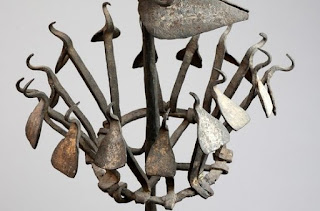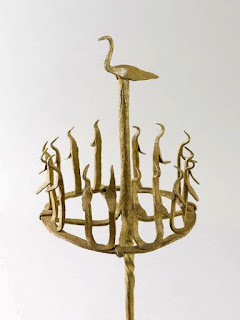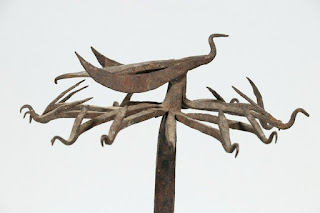The Cosmos in a Staff: The Glory of Ọpa Ọsanyin, an Understudied Example of Great Yorùbá Art Part 1: Avian Aesthetics
Abstract
A brief examination of Ọpa Ọsanyin, a great but understudied Yorùbá sculptural form, using one example of the art, exploring its imaginative conception, technical genius and associative range beyond the universe of Yorùbá culture.
The essay is enriched by images of an example of Ọpa Ọsanyin and of various kinds of birds, amplifying the ideas expressed in the text.
Imaginative Conception and Expressive Skill

Image Above
Ọpa Ọsanyin image from Pinterest, one of the best online sources for this sculptural form.
Ọpa Ọsanyin image from Pinterest, one of the best online sources for this sculptural form.
A conclave of voices, raised in adoration of the Supreme, is an idea suggested to me by this sculpture.
The classical Yorùbá art form Ọpa Ọsanyin is an animal centred art, a metal structure made up of a pole with birds clustered round it and a bird surmounting the pole or of only the single bird on top of the pole.
Ọpa Ọsanyin evokes birds in terms of the finest attributes, qualities suggested through the associative character of design and quality of sculptural construction, rather than through explicit reference.
These are accomplished in terms of a varied but consistent originality of conception and exquisite power of execution that makes Ọpa Ọsanyin one of the world's greatest artistic traditions.
In the image above, the aerodynamic grace of avian form is realized in the lyrical curves of the birds' necks flowing into streamlined bodies.

This lyricism is accentuated by the impression of the birds creating a graceful flying formation in their elevation through iron rods jutting smoothly from their forms, raising them above the circular platform on which they are located, as broad spans of iron flare out from their backs, indicating wings stretched out in flight.

This impression of flight assumes greater visual power and associative force in the airborne formation being depicted as directed towards a larger bird poised above those below, its more detailed elaboration of form along with its spatial elevation as the circle of smaller birds both gaze on and rise towards it giving it both physical and symbolic centrality.

The elevated avian presence is shaped by a graceful dynamism flowing from the delicate but firmly realized lyricism of the curve of its neck to its body.

This flow is complexified and accentuated by spirals constituting the wings and tail feathers of the bird.



A curved structure radiates outward from the left and right of the bird’s lower back to culminate at a point below the graceful curl of the spiral that constitutes the bird's tail feathers, creating a visual rhythm with the bird's form, suggesting a ballast of air on which the avian form is poised.

This sense of balance on a platform amplifies the sense of airborne power, of elevation, of consolidation, within itself, of the aspirations represented by the ring of smaller birds directed towards the elevated bird, even as, through its similar but more complex design, it integrates, complexifies and expands the aspirations suggested by similarities of structure and of airborne motion between itself and the smaller birds.

The sense of dynamism, of graceful action in space generated by the entire construct, is enhanced by the suggestion of correlative outward and inward motion indicated in the birds depicted as leaning away from the staff around which they are constellate, even as their frontal depictions are directed inward towards the staff.
This inward focus is intensified through the elegant upward motion of their necks as they face inward and upward to the larger, more complexly beautiful bird depicted as poised in flight above them.
Within a static form, therefore, through the varied but correlative ways in which the poise of the figures is crafted, the sculptor evokes impressions of flight, enriched by the sense of balance in space of a group of birds in formation.
Through the visual focus of the birds’ faces, this sense of flight through spatial balance is subtly directed towards a possible symbolic value represented by the centre of the bird’s attention, a visual focus amplified by emanating from all sixteen birds at once, the number sixteen being a recurrent figure in Ọpa Ọsanyin art, recurring in the number of birds organized around the larger bird in examples of Ọpa Ọsanyin.
Sixteen is one of the most significant numbers in Yorùbá discourse. It is the foundational number of Odu Ifa, the cosmological categories and organizational forms of Ifa, the most extensive Yoruba system of knowledge.
This association between sixteen birds and Odu ifa is therefore central to the understanding of the evocative range of Ọpa Ọsanyin within and beyond the Yorùbá universe.
These intracultural evocative values of Ọpa Ọsanyin emanating from the Yorùbá expressive and ideational complex shall be discussed in the third part of this essay.
This part lays foundations for appreciating the more general associative force of this art as it may speak to anyone without an understanding of its culture centred symbolism.
The second part which will examine the broad outlines of Yorùbá hermeneutics, strategies of interpretation of expressive forms such as art and existence in general, in relation to each other, helpful to better appreciating this art.
In this example of Ọpa Ọsanyin, through the suggestion of contrastive but complementary balance of inward and outward spatial orientation suggesting the general rhythms of bird flight, the artist creates variations within the fixed forms of Ọpa Ọsanyin art, generating creativity within tradition, individuality within convention, uniqueness within history.
Associative Possibilities Beyond the Yorùbá Universe
The Grandeur of Avian Structure and Motion
This sculptural piece is a magnificent realization of centuries of human response to the evocative values of the beauty of birds flying in formation, seemingly sharing one mind as they move in the same direction or change direction in unison.
''Where could they be going?,'' ''What is the constitution of this group intelligence?'' are questions generated by these marvelous sights.
This mysterious unity, realizing a magnificent beauty, stimulates the imaginative re-creation of these glorious forms in terms of meaning derived from human experience.
Wole Soyinka on Egrets in Flight
These imaginative recreations focus humanity's most exalted perceptions in terms of this wonder of nature, represented, for example, by Wole Soyinka's evocation, in A Shuttle in the Crypt (1977, 40-1), of birds seen from his prison window:
“A choir of egrets, servers at the day's
“A choir of egrets, servers at the day's
Recessional, on aisles fading to the infinite”
The egrets look to the imprisoned man as like both a choir and Mass servers assisting the priest at a Catholic church service. The white forms of the birds, moving in streamlined unity of motion, suggest to him both white robed choir members and attendants to the priest at Mass, in reverent movement towards the altar of a church, a church service constituted by the end of the day, ‘“the day’s Recessional.’’
Image Above
A flock of egrets in flight, taken by Elizabeth Kearley on the Lake Apopka Wildlife Drive at Lake Apopka in central Florida, USA.
This image of service in a church is stimulated by the sight of the birds flying in formation within the atmospheric conditions constituted by the end of the day, ''the day's recessional,'' the day receding in solemn beauty, withdrawing into the darkness of night to reemerge at dawn.
Image Above
Picture by skeeze/pixabay from Vasudevan Mukunth’s “When Birds Flock Around a Sphere, Beautiful Things Happen” at The Wire.
The radiant white of the bird forms progressing in formation into the distance also suggest to the watching Soyinka a movement into infinity as the images of the birds fades into the distance the farther away they move from his sight into the distant horizon.
Video of Birds in Flight Against Setting Sun by Sefoma at Shutterstock
The impression of progression into infinity by the ordered formation of many birds moving together in airborne motion is further concretized for Soyinka in his prison enclosure by the smoothness of the birds' motions suggesting the flow of of the passage between the pews in a church where people are seated, a passage that seems to extend forever, ''aisles fading to the infinite.''
Image Above
America's First Cathedral, the Basilica of the National Shrine of the Assumption of the Blessed Virgin Mary, Baltimore, Maryland, USA by MyLoupe at Getty Images.
Farid ud-Din Attar on the Quest for a King by the Birds of the World and
T.S.Eliot on Avian Motion as Suggestive of Spiritual and Philosophical
Progression
T.S.Eliot on Avian Motion as Suggestive of Spiritual and Philosophical
Progression
Farid ud-Din Attar ( in Manteq at-Tair,1177, first full trans. by Afkham Darbandi and Dick Davis as The Conference of the Birds,1984) also likely moved by the image of avian unity of purpose, flying in formation in migrating across great distances, visualizes the journey of a conclave of birds, representing all the birds in the world, in search of a king, a king whom, on reaching at last, turns out to be a cosmic essence constituting the essential identity of each of the birds who had sought him as their king, an essence un-realized by them till the culmination of their journey, a vision of journey and paradoxical consummation imaged by migratory avian motion also resonant in T.S.Eliot's closing lines in ''East Coker,''
“We must be still and still moving
Into another intensity
For a further union, a deeper communion
Through the dark cold and the empty desolation,
“We must be still and still moving
Into another intensity
For a further union, a deeper communion
Through the dark cold and the empty desolation,
The wave cry, the wind cry, the vast waters
Of the petrel and the porpoise. In my end is my beginning.”
Image Above
Picture by Kim Schandorff of view of sunset over Amazon river near Manaus, Brazil.
St. John on the Cross on Mystical Flight in Terms of the Flight of a Bird
Aquatic related motion, above the waters by far flying petrels, within the waters by the porpoise, as the crashing of waves and the sound of wind frames these motions, amplifying their dramatic and evocative power, becomes for Eliot an evocation of the human journey towards the consummating values represented, in other contexts, by Soyinka's evocations of infinity, by Attar's visualization of pervasive cosmic essence, a journey through darkness, cold and emptiness correlative with the ''vast waters'' of the oceans traversed by the petrel and the porpoise, but directed at suggesting the challenges of the mystical journey, a motion towards the kind of intensity and communion suggested by St. John of the Cross, in which
“ I flew so high, so high, I seized my quarry in the end
“ I flew so high, so high, I seized my quarry in the end
entering in, I knew not where
a darkness grand and tenebrous
the farther I climbed, the less I understood
transcending knowledge with my thought”

Image Above
Picture by Juan Manuel Pérez Rayego of a “bird soaring near a sundog,” “also called a mock sun or parhelion,” a small rainbow spotted off the side of the sun [caused by ] sunlight refracting through thin, falling ice crystals in the Earth's atmosphere. These crystals fall almost horizontally and refract the light sideways.’’
The quote from St. John of the Cross conjoins lines from John's ''Verses Written After an Ecstasy of High Exaltation'' and ''Other Verses with a Divine Meaning by the Same Author,'' as translated by Roy Campbell ( St. John of the Cross: Poems, 1968, 47-49, 55-57).
John employs the image of a bird in flight in evoking contemplative journey towards God, traversed through a darkness representing the distance of divine being from human understanding, embrace of which distance implies leaving behind what is ordinarily known to embrace that which is unknowable by ordinary means.
Image Above
“Bird in the Sky” by Chris Knorr.

Image Above
Bird in flight against sunset background.
Source yet unidentified.
Ọpa Ọsanyin at Intercultural Intersections of Humanity and Nature
From Soyinka's Christian imagery, to Attar's Islamic mysticism, to Eliot's evocations resonating with his grounding in the Christian mystical tradition represented by St. John of the Cross and John's depiction of spiritual journey in terms of mysterious darkness within a progression beyond the conventionally knowable, the image of birds in flight, in formation or singly, is the primary frame through which these writers visualize human aspiration, an aspiration towards something elevated above the human as conventionally understood but to which the human being is sensitive as a realization of their deepest potential, as the birds in the example of Ọpa Ọsanyin art above strain towards the bird poised in flight above them, a bird like themselves, but more regal, in its elevation and harmonious complexity of design.
Image Above
“Great egret / common egret / great white egret (Ardea alba / Egretta alba) flying over flock of swimming great cormorants (Phalacrocorax carbo) lake. (Photo by: Sven-Erik Arndt/Arterra/Universal Images Group via Getty Images).
“Great egret / common egret / great white egret (Ardea alba / Egretta alba) flying over flock of swimming great cormorants (Phalacrocorax carbo) lake. (Photo by: Sven-Erik Arndt/Arterra/Universal Images Group via Getty Images).
Enquiry on the Inspiration and Expressive Logic of Ọpa Ọsanyin
What, exactly, is Ọpa Ọsanyin?
What are its inspiration and the logic of its construction?
Why is it constructed in a manner that can evoke values of such universal penetration?
What are its inspiration and the logic of its construction?
Why is it constructed in a manner that can evoke values of such universal penetration?
To Be Continued.
An Invitation
You are invited to further participate in this journey of knowledge by materially empowering the steeds of discourse, the birds of knowing, the camels of the caravan, the weapons of knowledge.
I am committed to penetrating even the most recondite zones of knowledge within my fields of interest and sharing this knowledge in a manner that demonstrates its excitement, readily accessible to most readers and illuminating even for specialists.
I invite you to contribute to advancing this work by donating.
Your donations are strategic to the work of Compcros, Comparative Cognitive Processes and Systems, one of the largest collections of original research and publication by one person freely accessible online, embracing various disciplines and cultures.
I publish primarily on public access platforms represented by social media, blogs and websites, where people congregate in engaging in the varied business of living.
I thereby develop a Scholarship of the Marketplace, in the model of the ancient Greek philosopher Socrates, who engaged people in philosophical debate anywhere people were found, thereby dramatizing the philosophical quest as arising from and pervading all human activity.
I also self publish publish in the document archives academia.edu and Scribd and on Amazon publishing along with participating in print and digital publications with publishers dedicated to scholarly texts.




Comments
Post a Comment